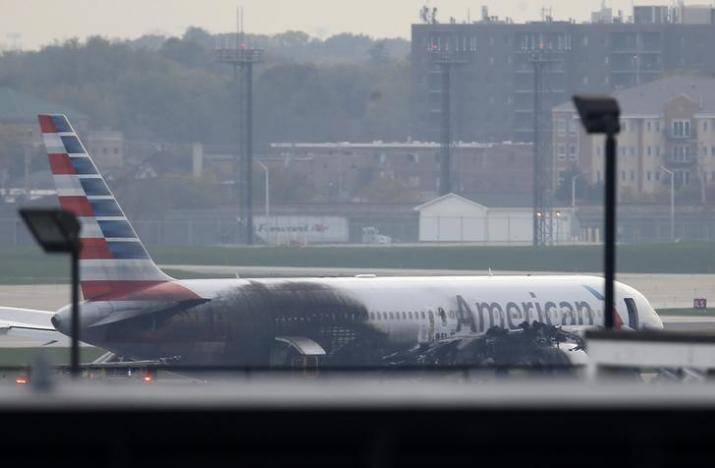An American Airlines jet engine that failed seconds before takeoff in a fiery runway accident at Chicago's O'Hare International Airport flung broken turbine parts as far as half a mile from the scene, a federal investigator said on Saturday.
Disclosure of the "uncontained" failure," in which internal engine parts breach the protective housing designed to keep them safely enclosed, even in a breakdown, came a day after a mishap that authorities said neared the point of disaster but caused no serious injuries.
Shrapnel escaping from the engine's outer cover can tear through the cabin or rupture fuel tanks in the wings.
Such engine failures are extremely rare, and National Transportation Safety Board (NTSB) investigators were looking for clues as to whether the fault lay with the engine itself, with its manufacture or a freak event such as debris on the runway entering the engine.
The General Electric (GE.N) engine that powered the plane was a workhorse model known as the CF6, introduced decades ago, GE spokesman Rick Kennedy told Reuters on Saturday. The American Airlines plane engine dates from the 1980s or 1990s, and had been serviced by the airline, he said.
American Airlines Flight 383, a twin-engine Boeing (BA.N) 767 bound for Miami with 161 passengers and a crew of nine, was headed down a runway for departure when the right-side engine failed, forcing the crew to abort takeoff, authorities said.
Leaking jet fuel caught fire under the wing, as the crew evacuated passengers via emergency exit chutes from the left side of the plane, and fire crews arrived to begin pouring foam on the flames within minutes.
One flight attendant and 19 passengers suffered minor injuries in their escape.
NTSB investigator Lorenda Ward told reporters at O'Hare on Saturday that while flames never breached the plane's cabin, some smoke did, though city fire officials have said no one suffered from smoke inhalation or burns.
City fire department officials said on Friday the plane was 15 to 20 seconds from becoming airborne, fully loaded with 43,000 pounds of jet fuel. Ward said the aircraft stopped about 3,000 feet from the end of the runway. "That's a lot of runway to have left," she said.
FAR-FLUNG ENGINE DEBRIS
In a sign of the intensity of the engine breakdown, at least two pieces of a stage-2 high-pressure turbine disk were flung from the scene.
One was found at a United Parcel Service warehouse nearly 3,000 feet (915 meters), or about half a mile, south of the accident site. Another was found three-tenths of a mile to the north on airport property, NTSB investigator Lorenda Ward told reporters at O'Hare on Saturday.
She said the escaped engine parts would be shipped to a lab for examination, and the crippled right engine would be sent to a GE facility to be dismantled and examined there for clues to what caused the failure.
American on Saturday declined to provide details about the aircraft, engine or maintenance, referring questions to the NTSB.
Officials from GE Aviation, Boeing and American Airlines were on the scene at O'Hare assisting in the investigation, GE's Kennedy said.
The CF6 was introduced in the 1970s, and more than 4,000 are currently in service on seven different wide-body jetliner models, including the Boeing 747 and 767, and Airbus A300 and A330, according to GE. The engine has racked up more than 400 million flight hours and has a record of "industry-leading levels of reliability," Kennedy said.
The O'Hare incident marks the third uncontained GE engine failure in little over a year, following a British Airways Boeing 777 in September 2015 and a Southwest Airlines Boeing 737 in August. Both aircraft used different engines, the GE90 and CMF56, made by a joint venture of GE and Safran of France.
In a full-power ground test situation in 2006, an American Airlines 767 with GE CF6 engines suffered an uncontained failure, according to a summary produced by the Aviation Safety Network, a service of the Flight Safety Foundation, an international nonprofit based in Alexandria, Virginia.
The high pressure turbine of the CF6-80A engine used on the 767 has been cited in six regulatory actions by the Federal Aviation Authority since 1986, FAA records show. The most recent, in 2009, required airlines to remove an engine rotor within 30 days and reduced the allowed lifespan of an engine disk, conditions that could lead to cracks and uncontained engine failure, according to FAA records.






